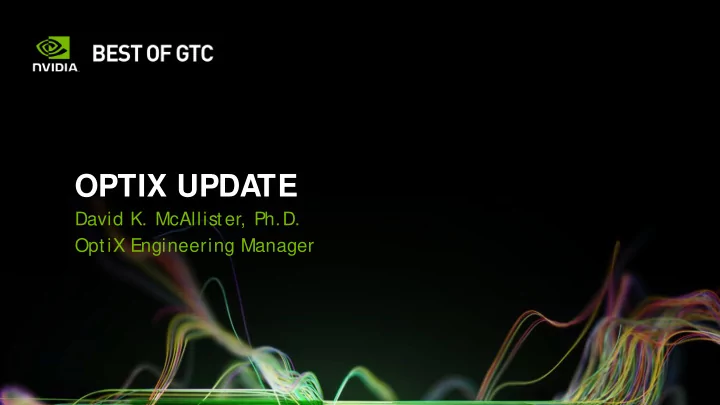

OPTIX UPDATE David K. McAllister, Ph.D. OptiX Engineering Manager
OPTIX UPDATE OptiX Introduction Current Goodness Upcoming Goodness S pecial Guest
RENDERING
RENDERING WITH RAY TRACING S ampling — What rays t o t race? Ray tracing — What do t he rays hit ? S hading — What color are t he rays?
RAY TRACING IN THE ABSTRACT Given a ray (O, D) and a geometric dataset find — any hit ? — closest hit — all hits Current datasets ~1M -> 100M primitives, usually triangles Use a spatial data structure optimized for these operations Datasets can also include GB of other data like textures
ACCELERATION STRUCTURES Bounding Volume Hierarchy (BVH)
GPUS – THE PROCESSOR FOR RAY TRACING Abundant parallelism, massive computational power GPUs excel at shading Opportunity for hybrid algorithms
RAY CASTING (APPEL, 1968)
REAL TIME PATH TRACING What would it take? GeForce GTX Titan: — 4 rays / sample — 350M rays / second — 50 samples / pixel — Need 34X speedup — 2M pixels / frame — 30 frames / second — 12B rays / second 1 shading sample 9 shading samples 18 shading samples 36 shading samples 72 shading samples 144 shading samples 1 AA sample 1 AA sample 2 AA samples 4 AA samples 8 AA samples 16 AA samples
DESIGN GARAGE: ITERATIVE PATH TRACER Closest hit programs do: — Direct lighting (next event estimation with shadow query ray) — Compute next ray (sample BS DF for reflected/ refracted ray info) — Return direct light and next ray info to ray gen program Ray generation program iterates along path
DESIGNGARAGE: ITERATIVE PATH TRACER RT_PROGRAM void rayGeneration() { float3 ray_dir = cameraGetRayDir(); float3 result = tracePathRay( camera.pos, ray_dir, 1 ); output_buffer[ launch_index ] = result; } RT_PROGRAM void closestHit() { // Calculate BSDF sample for next path ray float3 ray_direction, ray_weight; sampleBSDF( wo, N, ray_direction, ray_weight ); // Recurse float3 indirect_light = tracePathRay(P, ray_direction, ray_weight); // Perform direct lighting ... prd.result = indirect_light + direct_light; }
DESIGNGARAGE: ITERATIVE PATH TRACER RT_PROGRAM void rayGeneration() { RT_PROGRAM void closestHit() { // Calculate BSDF sample for next path ray PerRayData prd; float3 ray_direction, ray_weight; prd.ray_dir = cameraGetRayDir(); sampleBSDF( wo, N, ray_direction, ray_weight ); prd.ray_origin = camera.position; float3 weight = make_float3( 1.0f ); // Return sampled ray info and let ray_gen float3 result = make_float3( 0.0f ); // iterate prd.ray_dir = ray_direction; for( i = 0; i < MAX_DEPTH; ++i ) { prd.ray_origin = P; traceRay( prd.ray_origin, prd.ray_weight = ray_weight; prd.ray_dir, prd ); // Perform direct lighting result += prd.direct*weight; ... weight *= prd.ray_weight; prd.direct = direct_light; } } output_buffer[ launch_index ] = result; }
WHAT’S THE LATEST
REGISTERED DEVELOPER PROGRAM Access latest OptiX version Access private beta releases Tighter communication with OptiX developers 800 registered developers in 4 months
OPTIX 3.6 CUDA 6 support Maxwell (S M 5.0) support — Great performance Callable Program IDs — Use with Bindless Buffer IDs and Texture IDs — Finishes our composable shading solution — S ee Pixar, Danny Nahmias, NVIDIA Theater, Tue.3:20 Optimized CPU ray tracing in OptiX Prime (Commercial)
ACCELERATION BUILDER OPTIONS Sbvh Fast Render Trbvh Bvh MedianBvh Lbvh Slow Render Slow Build Fast Build
TRBVH MEMORY FOOTPRINT IMPROVED S cratch space used to limit build size Also, 2 GB max build size For a 40 million triangle model — Before 4.5 GB — Now 2.8 GB Builds Trbvh in chunks. — Chunk size parameter — Virtually the same ray tracing performance Both OptiX and OptiX Prime
OPTIX PRIME S pecialized for ray tracing (no shading) Replaces rtuTraversal (rtuTraversal is still available) Improved performance — Uses latest algorithms from NVIDIA Research ray tracing kernels [Aila and Laine 2009; Aila et al. 2012] Treelet Reordering BVH (TRBVH) [Karras 2013] — Can use CUDA buffers as input/ output — S upport for asynchronous computation S hips with OptiX 3.6
PRIMARY Mrays/s OPTIX PRIME RAY TRACING PERFORMANCE 100.0 200.0 300.0 400.0 500.0 600.0 700.0 800.0 0.0 Arabic Armadillo Babylonian Bar Blade Bubs Buddha City Conference Crown Crytek-Sp Dragon Fairy Hairball Italian Motor Mustang PowerPla-16 Sibenik Soda Vegetation Veyron-NG
OPTIX PRIME RAY TRACING PERFORMANCE DIFFUSE Mrays/s 100.0 150.0 200.0 250.0 300.0 350.0 50.0 0.0 Arabic Armadillo Babylonian Bar Blade Bubs Buddha City Conference Crown Crytek-Sp Dragon Fairy Hairball Italian Motor Mustang PowerPla-16 Sibenik Soda Vegetation Veyron-NG
OPTIX PRIME RAY TRACING PERFORMANCE This is the best single-chip ray tracing performance ever reported. By more than 2X.
WHAT’S COMING
MAJOR ARCHITECTURAL RENOVATION LL VM-based OptiX compiler Priorities — Better GPU ray tracing performance — More fluid interactive rendering — Better multi-GPU scaling — More efficient complex node graphs — Additional input languages — CPU backend
UNIFIED VIRTUAL MEMORY Merges CPU and GPU memory spaces Full read/ write access from both processors Eliminates GPU memory footprint barrier Coming in Pascal architecture (2016)
NVIDIA VCA Under the Hood GPUs 8 x K6000-VCA GPUs GPU Memory 12 GB per GPU CUDA Cores 23,040 CPU Cores 20 S ystem Memory 256 GB S torage 4 x 512GB S S D 2 x 1GigE Network 2 x 10GigE (S FP+) 1 x InfiniBand Cent OS Linux + Iray IQ Installed S oftware + VCA Cluster Manager U.S . MS RP $50,000
OptiX on VCA Coming Next Year Ethernet or Custom OptiX Applications Internet All Processing on VCA Incremental OptiX Leveraging Updates S ame Infrastructure as Iray (using DiCE) OptiX App Minimal Work within the OptiX App Interactive Image S tream
MOVING PICTURE COMPANY Damien Fagnau — Global Head, VFX Operations
OPTIX AT SIGGRAPH OptiX on Titan Z and VCA, NVIDIA booth, Tue. – Thu. Iray on NVIDIA VCA, NVIDIA booth, Tue. – Thu. Recent Advances in Light-Transport, room 109, Tue. 2:00 Pixar, Danny Nahmias, NVIDIA Theater, Tue.3:20 Bunkspeed with Iray Interactive, NVIDIA Theater, Wed. 12:00 MPC, Damien Fagnou, NVIDIA Theater, Wed. 12:40
Recommend
More recommend